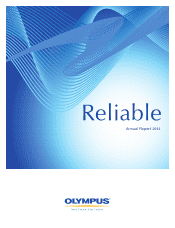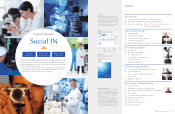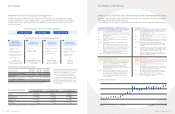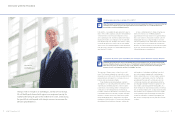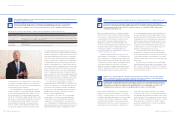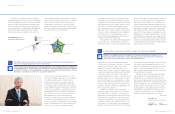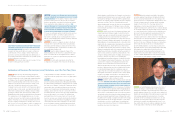Olympus 2014 Annual Report Download - page 11
Download and view the complete annual report
Please find page 11 of the 2014 Olympus annual report below. You can navigate through the pages in the report by either clicking on the pages listed below, or by using the keyword search tool below to find specific information within the annual report.
Past, Present, and Future of Olympus—Conversation with Analysts
Opinions, Advice, and Hopes for Olympus
Shibano Even looking at the entire world, there are very few
companies whose business could be truly described as
“strong.” As such, Olympus is a rarity. In emerging countries,
Olympus may have to face the threat of increasingly more
powerful local companies as time progresses. My greatest
hope is that the Company will continue to conduct the
investments necessary to grow its business and maintain its
current position of superiority over the long term. I look forward
to seeing Olympus develop its businesses while leveraging its
strengths, and this sentiment applies not only to the Medical
Business but also to the Imaging Business and the Scientifi c
Solutions Business. In regard to investor relations activities, the
amount of information disclosed has increased substantially
over the past two years. I am most satisfi ed with these
Koike Olympus has a dominating share of the market for
gastrointestinal endoscopes, and it is easy to imagine that
sales would increase if the Company introduced a new
product in this area. In surgical devices, meanwhile, Olympus
is currently expanding its sales force. I imagine this being an
area of uncertainty for investors, who may be unsure as to
whether or not the market for these products is one in which
increasing sales personnel will have a signifi cant benefi t. With
regard to future product strategies as well, I believe you could
better communicate the Company’s growth path by disclosing
information about what products will be introduced into what
regions and when.
Sasa While I cannot disclose specifi c details, I can give a
general overview of our plans. Take for example, THUNDERBEAT,
an energy device. As a future step in the development of this
product, we are considering applying its technology to the fi eld
of open surgery. We also realize the necessity of expanding
therange of THUNDERBEAT probes to make this device
applicable to a wider range of surgeries. This step will be
important in increasing the presence of THUNDERBEAT in
operating rooms. At the same time, we will need to develop
techniques for utilizing these devices and train physicians in
their usage. Our surgical device sales force will also require
training, as we will not be able to compete with other
manufacturers if sales personnel do not possess a deep
understanding of these techniques.
Watanabe It is hard to grasp the whole of the Company’s
business by looking at it as merely a minimally invasive
treatment company. This is particularly true for surgical
endoscopes, partially because the appropriate level of market
penetration for these devices varies by component. Even
gaining this basic understanding is diffi cult for investors, and
looking at Olympus at this level alone will not grant a clear
picture. Even if you are unable to disclose specifi c details,
it would be most helpful to investors if you could give some
concrete idea of what type of demand is present in what parts
of medical institutions.
Sasa The general surgery fi eld is very broad. We aim
to expand the usage of THUNDERBEAT in areas of this
fi eld in which its strengths will be a true asset. For example,
THUNDERBEAT boasts exceptional performance in terms of
stopping bleeding and the speed at which it makes incisions.
Operations on certain organs present immense diffi culty in
simultaneously preventing blood loss while making incisions.
We hope to spread minimally invasive procedures for such
operations by promoting the use of THUNDERBEAT. In
addition, we are advancing the GI in the OR surgical device
strategy, which entails encouraging physicians to use
gastrointestinal endoscopy in the operating room. Our
gastrointestinal endoscopy systems developed for Europe and
the United States are confi gured for connecting to a surgical
endoscope, giving them a signifi cant advantage. A survey
conducted by Olympus showed that roughly 30% of hospitals
routinely use gastrointestinal endoscopes in the operating
room. These devices are used for such applications as
confi rming whether or not stitching conducted during surgeries
has created a suffi cient seal.
Watanabe That is remarkable. So you mean to say that
gastrointestinal endoscopes are used for diagnosis, treatment,
and even confi rmation.
proactive activities, particularly such examples as the tours
of the Olympus gastrointestinal endoscope plant in Aizu,
Fukushima Prefecture, and the explanatory meetings and tours
of the training center held in Guangzhou in China. However,
there is still so much more I want to know about the Company’s
business. I hope that you will expand upon these activities in
the future.
Koike Looking at the Company’s investor relations activities,
I am particularly impressed with the small meetings held be-
tween analysts and yourself following quarterly fi nancial results
presentations and the teleconferences conducted targeting
overseas investors on the night of presentations. This sort of
effort is highly appreciated and differentiates Olympus from
other companies. I believe that many investors hold these
activities in very high regard, and this is especially true for
overseas investors, who are rarely able to receive timely infor-
mation disclosure from Japanese companies. I hope these
activities will continue. Looking to the future, technological
innovation will become more crucial than ever, and this applies
to medical equipment manufacturers worldwide. If technolo-
gies do not advance, it will be diffi cult to receive approval for
premium pricing rates under insurance systems. Were such
a situation to occur, product selling prices could drop, subse-
quently creating a downward spiral. Such a development is
a major risk inherent in the medical equipment industry.
Olympus has signifi cant room to breed new innovation in the
endoscope and surgical device fi elds, and there are still numer-
ous business opportunities for the Company to exploit. Whether
or not Olympus can maintain its current high growth rates over
the next 10 or 20 years is a concern often held by investors.
In order to dispel this concern, I think Olympus should be even
more proactive in its disclosure efforts. That would be a sure
way to secure the ongoing support of capital markets.
Watanabe Both in Japan and overseas, we see a major
corporate scandal once every couple of years. While Olympus
caused one such scandal, it has since managed to overcome
this setback, and it has actually become stronger than other
companies that have been involved in scandals as a result. This
improvement in strength was not only limited to governance.
I therefore hope that Olympus will serve as an example for capital
markets of how a company can move past such adversity.
Also, I understand that Olympus is the only Japanese medical
equipment manufacturer to conduct its business through
collaboration with academia. Mr. Koike hinted at the decline in
new technological innovations. Hopefully, Olympus will be able
to uncover innovation through its work with academia and use
this innovation to drive growth over the coming decade. I
believe that the medical fi eld is a core area in which Japan can
make contributions to the rest of the world. Olympus has the
potential to contribute to Japan’s manufacturing industry in
terms of both tangible and intangible elements as well as from
other angles, such as the culture of the industry itself. I strongly
hope that Olympus will actively lead the medical fi eld, both in
Japan and on the wider global scale.
Sasa The market is constantly changing for all fi elds
in which we operate. As I mentioned earlier, an important
point going forward will be the extent to which we utilize
the Company’s assets and act fl exibly in response to market
change. The medical equipment industry is transforming on a
global scale as marked by prominent M&A activities and other
developments. Some companies are growing by becoming
holding companies and skillfully managing numerous
companies below them. Olympus, however, is not suited
to this type of structure in my opinion. As symbolized by
our slogan of “Back to Basics,” I believe that Olympus is
a company that is most suited to focusing entirely on
manufacturing, and this is where our expertise and managerial
competence lies. It is vital that we accurately determine what
our strengths are, and how we should respond to change, and
in turn act accordingly. Recently, we approved plans to
conduct upfront investment in business-to-business
operations in the Imaging Business. With regard to this
endeavor as well, we will need to ascertain what we can
achieve with the Company’s current management resources.
The same must be done in the Medical Business. Looking
ahead, a central concept in our management is the creation of
a vision for the future Olympus by overlapping the potential
accomplishments of our resources.
Thank you for joining us today. I hope to draw on your valuable
input and insight in management to create an Olympus that
lives up to your expectations.
19
OLYMPUS Annual Report 2014
18 OLYMPUS Annual Report 2014

